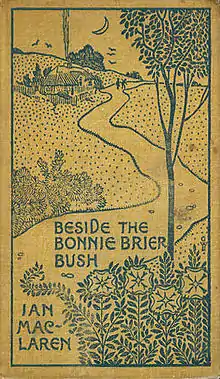Kailyard school
The so-called Kailyard school of Scottish fiction (1880–1914) dates from the last decades of the 19th century. It was first given the name in an article of April 1895 in the New Review[1] by J.H.Millar, though its editor W.E. Henley was heavily implicated in the creation of the term. [2]The criticism was that a certain group of Scottish authors offered an overly sentimental representation of rural life,[3] but was potentially more a gripe against the popularity of the authors. .[4] The name derives ultimately from the Scots "kailyaird" or "kailyard", which means a small cabbage patch (see kale) or kitchen garden, usually adjacent to a cottage;[5] but more immediately from Ian Maclaren's 1894 book Beside the Bonnie Brier Bush whose title alludes to the Jacobite song "There grows a bonnie brier bush in our Kailyard".[6]

Writers who have been linked to the Kailyard school included J. M. Barrie, Ian Maclaren, J. J. Bell, George MacDonald, Gabriel Setoun, Robina F. Hardy and, S. R. Crockett.
Works such as Barrie's Auld Licht Idylls (1888), A Window in Thrums (1889), and The Little Minister (1891); and Crockett's The Stickit Minister (1893) considered examples of the so called 'school'.[7]
The Kailyard label, once applied, proved hard to shift. Criticism came from certain branches of the English literary establishment including W.H.Crosland and from fellow Scots such as George Douglas Brown who aimed his 1901 novel The House with the Green Shutters explicitly against what he called "the sentimental slop"[8] of the Kailyard school. Much of Hugh MacDiarmid's work, and the Scottish Renaissance associated with him, was a reaction against supposed Kailyardism.[9] [10]
Scottish literary criticism right up till the 1980s appropriated (and mis-appropriated) the term but recently it has undergone some revisionist critiquing, including by Andrew Nash in his 2007 'Kailyard and Scottish Literature' [11] who notes that it was a social construct rather than an actual literary movement. The reputations, particularly of J.M.Barrie and S.R.Crockett have still to be reclaimed from what was essentially a publishing spat, directed largely against William Robertson Nicoll by English Conservative publishers in what might today be seen as an example of cultural imperialism.
John Ashbery references the school in his book of poems, April Galleons, his protagonist lamenting mildly that "nobody I know ever talks about the Kailyard School, at least not at the dinner parties I go to".[12]
References
- Millar, J.H. (1895). "The Literature of the Kailyard". The New Review.
- Donaldson, Islay Murray (2016). The Life and Work of S.R.Crockett. Ayton Publishing. p. 94. ISBN 9781910601143.
- D. Daiches ed., The Penguin Companion to Literature: 1 (1971) p. 288
- I. Ousby ed., The Cambridge Guide to Literature in English (1995) p. 503
- Cuddon, J. A. (1977) A Dictionary of Literary Terms. London: André Deutsch; p. 343
- Macdonald, A. M., ed. (1972) Chambers Twentieth Century Dictionary. Edinburgh: Chambers; p. 716
- D. Daiches ed., The Penguin Companion to Literature: 1 (1971) p. 288 and p. 126
- D. Daiches ed., The Penguin Companion to Literature: 1 (1971) p. 157
- Andrew Nash, Kailyard and Scottish Literature (2007) p. 15
- Campbell, Ian (1981), Kailyard: A New Assessment, The Ramsay Head Press, Edinburgh
- Nash, Andrew (2007). Kailyard and Scottish Literature. Rodolpi.
- John Ashbery, Notes from the Air (2007) p. 27
Further reading
- G. Blake, Barrie and the Kailyard School (1951)
- A. Nash, Kailyard and Scottish Literature (2007)
External links
- Kailyard School (1886-1896), The Literary Encyclopedia
- Scots Word of the Season: Kailyard, Maggie Scott, Lecturer in English Language, University of Salford, published in The Bottle Imp ezine by the Association for Scottish Literary Studies.